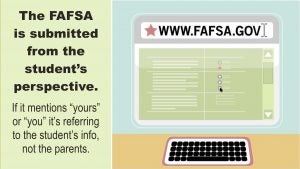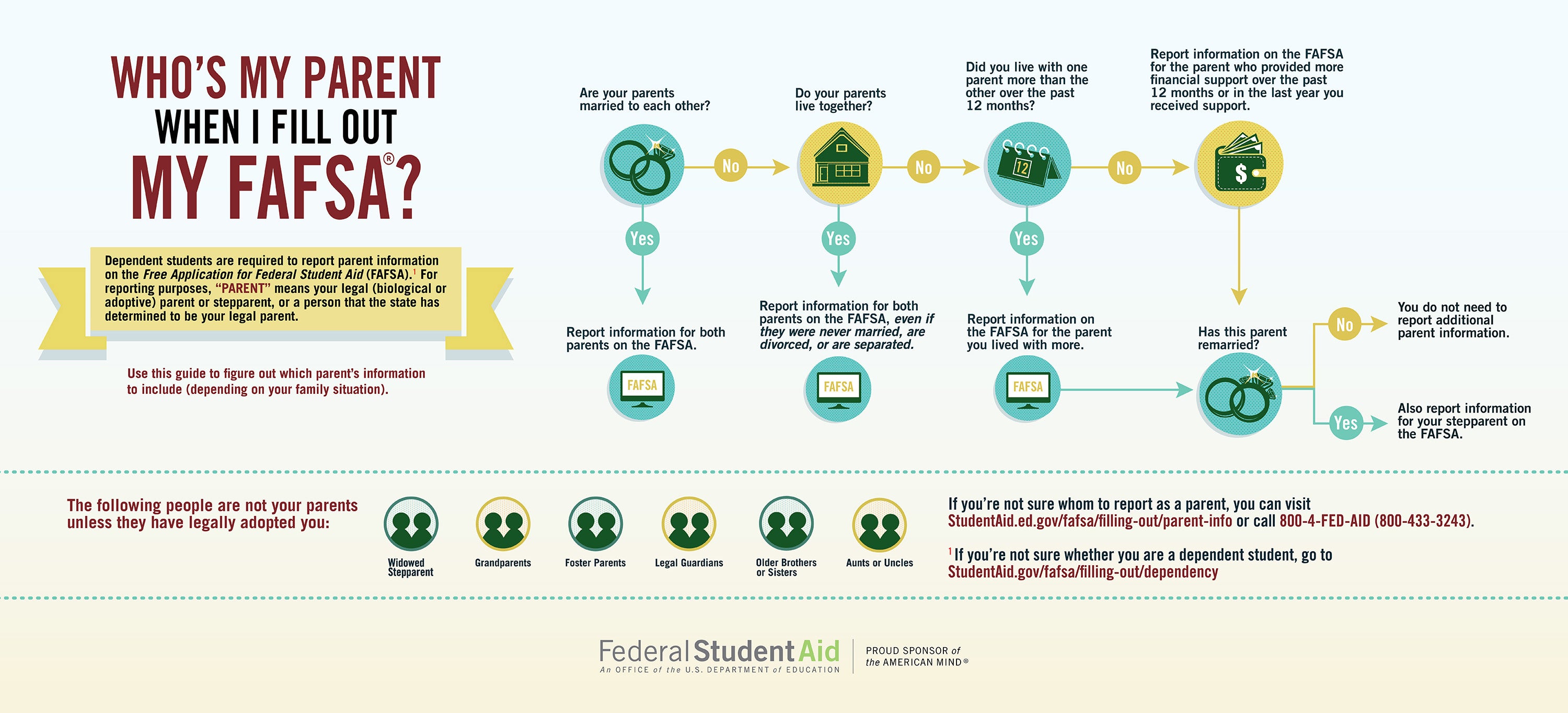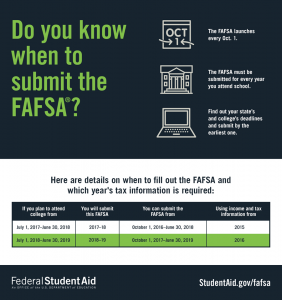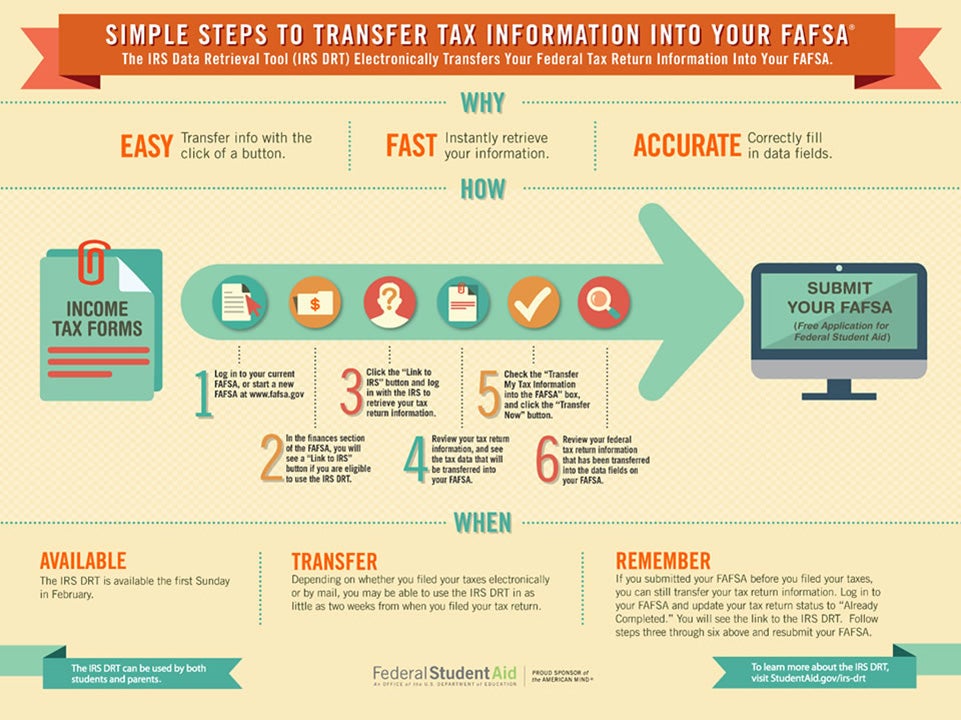Overview
Applying for Financial Assistance
Because the costs of higher education must often be offset by some form of financial assistance, we encourage you to apply for financial aid.
Completing and submitting the Free Application for Federal Student Aid (FAFSA) at www.studentaid.gov gives you access to the largest source of financial aid – grants, loans, and student employment. The application processing cycle lasts 21 months. For the 2024-25 award year, applications are accepted beginning late December 2023 through June 30, 2025. For the 2025-26 award year, applications are accepted beginning October 1, 2024 through June 30, 2026.
Applying for financial aid can be a daunting task, so we have outlined the steps to apply. First, check out this video for an overview of the FAFSA process.
Please allocate one hour to complete the FAFSA. Collect the following information before completing the FAFSA:
- FSA ID (a contributor(parent) will also need an FSA ID if the student is dependent). If the parent/stepparent filed taxes separately from their spouse they will also need a FSA ID. For an independent student, a student’s spouse may also need a FSA ID if taxes were filed separately). Instructions on how to create an FSA ID are below.

- Social Security Number (if applicable). If you don’t have a SSN, an alternative method is available.
- Your own mobile phone and/or email address
- Permanent address
- Contributors/Parent’s Social Security Number (if the student is dependent)
- Alien Registration Number (if the student is not a U.S. citizen)
- Marshall University’s Federal School Code: 003815
- You will retrieve your federal tax information by using the IRS Direct Data Exchange (IRS DDX). If you are not able to use the IRS DDX, you will need your Federal tax information or tax returns, including W-2 information, for you (and your spouse, if you are married), and for your parents, if you are a dependent student
- Records of untaxed income, which include foreign income if that income was exempt from U.S. taxation or foreign income for which the individual received a foreign tax credit.
- Current balances of cash, savings, and checking accounts
- Net worth of investments, businesses, and farms
- Asset information, which includes but is not limited to child support received, vacation homes, value of family farms and businesses.
- On the studentaid.gov website, select create account. Once you’re on the create account page, select the get started button.
- Next, you will create a unique username and password, and enter your e-mail address.
- Enter your personal information.
- Provide your name, date of birth, and Social Security Number.
- Include your permanent mailing address, e-mail address, telephone number, and language preference.
- Select your communications preference, either by email or mail.
- Provide answers to 4 challenge questions.
- Enable two-step verification. You can choose email and text message, or an authenticator app.
- Once you enable two-step verification, a back up code will be generated. Store this code in a safe place in the event that you cannot use any other two-step verification method.
- The FSA ID is now successfully created.
- A confirmation email will be sent.
- Take note of your user name and password and keep them in a safe place.
Only the owner of the FSA ID should create and use the account. NEVER share your FSA ID or password. The FSA ID contains personal identification information you should never share.
Before you complete the FAFSA, you must set up at least one two-step verification method (SMS text, email or authenticator app) to log in to your studentaid.gov account. Two-step verification, a form of multi-factor authentication (MFA), helps protect your StudentAid.gov account with an additional layer of protection from fraud. Each time you log in, you’ll be asked to provide a one-time code that is delivered to you via email, text message, or an authenticator app.To apply for financial aid, you (student) must file the FAFSA at studentaid.gov. Only the student should complete the FAFSA with the assistance of a contributor/parent if their information is required.Filing the FAFSA gives you access to federal grants, loans, and work-study. When you file the FAFSA, you will also be considered for state and institutional financial aid. State aid programs may require the completion of additional forms or applications. WV residents refer to the WV State Level Application for instructions on applying for WV state aid. Some scholarship applications may require you to include your Student Aid Index (SAI), which will show on your FAFSA Submission Summary.You must include Federal School Code 003815 if you want Marshall University to receive your FAFSA. The priority deadline is March 1st.Find out how to complete the FAFSA with this video:https://www.youtube.com/watch?v=9apxxQrx-WYFor assistance completing the FAFSA, you may call the Federal Student Aid Information Center at 1-800-4-FED-AID (1-800-433-3243) or look for the Help Tip box on the right side of the page while completing FAFSA on the Web.
WV residents should visit www.cfwv.com to apply for West Virginia’s merit-based PROMISE Scholarship and other scholarship programs administered by the WV Higher Education Policy Commission. For the list of state grants and scholarships that Marshall awards, visit the Types of Aid webpage.
Students applying for the WV PROMISE Scholarship and the WV Higher Education Grant Program must also file the Free Application for Federal Student Aid (FAFSA) at studentaid.gov.
FAFSA Deadlines for WV State Aid
-
-
- March 1 for WV PROMISE Scholarship
- April 15 for WV Higher Education Grant
-
WV PROMISE Scholarship
Students must also complete a state-level financial aid application at www.cfwv.com by March 1. In addition, high school graduating seniors must take the ACT or SAT by the scheduled dates in June and earn the necessary scores. The criteria for this scholarship are listed at www.cfwv.com.
For help completing the WV PROMISE Scholarship application or questions about it or the WV Higher Education Grant, you should call the West Virginia Higher Education Policy Office of Financial Aid and Outreach Programs at 1-888-825-5707 or 1-304-558-4614.
Searching and applying for scholarships is another way to help pay for college. Scholarships can be found from a variety of sources such as local businesses, organizations, churches, etc. but do require some research.
Marshall University Merit-Based Scholarships
These require no application. All first-time freshmen admitted to the university are considered for these scholarships based on test scores and GPA.
Explore our Merit-Based Scholarships to find out what you may qualify for.
Marshall University Foundation Scholarships
Many donors have given to Marshall University for privately funded scholarships, which have been made available for Colleges and Departments, to select students.
Searching for Scholarships
Scholarships do require research. Remember to think outside the box. Not all scholarships are academically based. Are you left-handed? Search for scholarships based on being left-handed. Are you a first-generation student? Do you participate in bowling leagues? Do you like asparagus or any other vegetable? There may be scholarships based on things you are interested in or participate in or are unique to you. You do have to seek out these scholarships so go search!
Start your search by checking out these sites:
As a courtesy to students, we’ve posted a list of Outside Scholarship Organizations, that have contacted this office to assist with soliciting applications. Marshall University has no affiliation with these organizations with regard to the development of the scholarship program or selection of the recipients.
Scams
You should never be required to pay a search fee for scholarships. Any site asking for payment is probably a scam.
The Department of Education or Marshall may select any student’s FAFSA for a process called Verification. Approximately one third of all college students are selected for FAFSA verification. Selected students are required to complete an online worksheet as well as providing selected documentation if needed. If this is required, you will receive an email instructing you to log onto mymu.marshall.edu . Upon submission of your documents, your financial aid counselor will review and let you know if there is any further action required on your part.
Other documents such as but not limited to birth certificates, passports, or marriage licenses may be required. Your financial aid office will notify you if needed. If you do not receive an email notification from us, that means you were not selected for verification. For detailed information on verification, click here.
Click to view instructions on how to accept or decline your aid. Remember, if you need loans to help cover your costs, you must accept the loans offered and complete the Master Promissory Note and Entrance Counseling.
The federal government requires a student to participate in loan counseling prior to receiving a Federal Direct loan. Federal Direct Loan Entrance Loan Counseling will explain various aspects of student loans, such as repayment and interest, and your rights and responsibility. It concludes with a 15-question quiz. You must get all answers correct to successfully complete Federal Direct Loan Entrance Loan Counseling. In addition, students borrowing a Federal Direct loan must complete a Federal Direct Loan Master Promissory Note (MPN) before loan money can be disbursed. Once a Federal Direct Loan MPN is completed and the loan is disbursed to your student account, you do not have to sign a Federal Direct Loan MPN again (it is valid for 10 years once your first loan installment disburses).
You will need your U.S. Department of Education FSA ID to successfully complete the MPN and Entrance Counseling. After you complete, the results will be sent electronically to Marshall University.
You only have to complete Federal Direct Loan Entrance Loan Counseling once, prior to your first Federal Direct loan disbursement.
-
-
- Log on to studentaid.gov
- Select Loans and Grant
- Select Loan Entrance Counseling
- Click the appropriate student status to login and start the counseling.
- Follow the on-screen instructions.
- Next, go back to the Home Page.
- Select Loans and Grants
- Select Master Promissory Note (MPN).
- Click the appropriate student status to login and finish the MPN.
- Follow the on-screen instructions.
-
Frequently Asked Questions
Federal financial aid regulations dictate the criteria under which a student applies independently of contributors/parents for financial aid. Students are considered “Independent” for financial aid eligibility if one or more of the following conditions are met:
-
-
- You are 24 years of age or older
- You are married as of the date you file the FAFSA
- At the beginning of the academic year, you will be working on a master’s or doctorate program or graduate certificate
- You are currently serving on active duty in the U.S. Armed Forces for purposes other than training
- You are a veteran of the U.S. Armed Forces
- You have children who will receive more than half of their support from you during the academic year you will be enrolled
- At age 13 or older, both of your parents (no living biological or adoptive) were deceased
- At any time since you turned 13, you were a ward of the court or you were in foster care.
- You are an legally emancipated minor as determined by the court as of the date you file the FAFSA
- As of the date, you file the FAFSA you are in legal guardianship with someone other than their parent or stepparent as determined by a court
- At any time on or after the date-specific on the FAFSA you were an unaccompanied youth who was homeless or self-supporting and at risk of being homeless
-
If one of the conditions above is applicable to you, you may submit the FAFSA without providing contributor/parental information. However, the Office of Student Financial Assistance is required under certain circumstances to document some of the “Independent” student conditions above. You will be contacted if further information is required.

-
-
- Complete and electronically sign the FAFSA
- Electronically sign a Master Promissory Note for a Federal Direct Loan
- Complete entrance and exit loan counseling for a Federal Direct Loan
- View your federal financial aid history.
-
-
-
- Electronically sign the FAFSA
- Apply for a Federal Direct PLUS (Parent) Loan
- Electronically sign a Master Promissory Note for a Federal Direct PLUS (Parent) Loan
- Electronically sign a Master Promissory Note for a Federal Direct PLUS (Parent) Loan
-
- Contact FSAIC at 1-800-433-3243
- A Customer Service Representative will look up your account and initiate the identify verification process
- You will receive an email with a case number and instructions for providing the proper documentation for us to verify your identity
- Submit the required documentation
- Complete attestation form available on studentaid.gov
- Proof of Identity:
- ONE of the following forms of ID
- Driver’s License
- State or City Identification Card
- Foreign Passport
- ONE of the following forms of ID
OR
- A UTILITY BILL AND ONE of the following forms of ID
- Municipal identification card
- Community ID
- Consular identification card
Within 1-3 days, FSA will provide an email confirming that your identity has been verified.
 The FAFSA becomes available at studentaid.gov on October 1 and closes on June 30 two years later. Example: The 2025-26 FAFSA opens October 1, 2024, and closes June 30, 2026.The FAFSA requires income information for the specified tax year. Be mindful that other household information may not be based on the tax year but dates specified on the FAFSA.For example, child support received is based on the most recently completed calendar year, which may not be the tax year for which is being reported.Remember, if you wait until the last minute to apply, some financial aid programs may not be available to you because they are first-come, first-serve. Also, your financial aid awards may not be finalized by the billing due date.
The FAFSA becomes available at studentaid.gov on October 1 and closes on June 30 two years later. Example: The 2025-26 FAFSA opens October 1, 2024, and closes June 30, 2026.The FAFSA requires income information for the specified tax year. Be mindful that other household information may not be based on the tax year but dates specified on the FAFSA.For example, child support received is based on the most recently completed calendar year, which may not be the tax year for which is being reported.Remember, if you wait until the last minute to apply, some financial aid programs may not be available to you because they are first-come, first-serve. Also, your financial aid awards may not be finalized by the billing due date.
